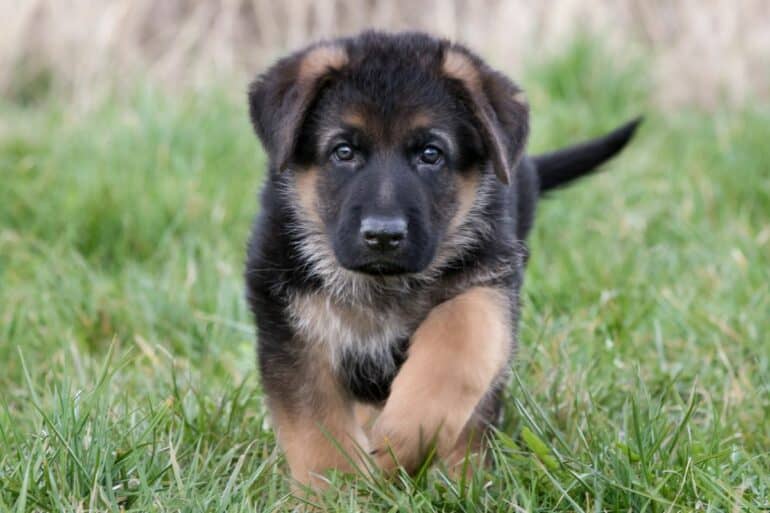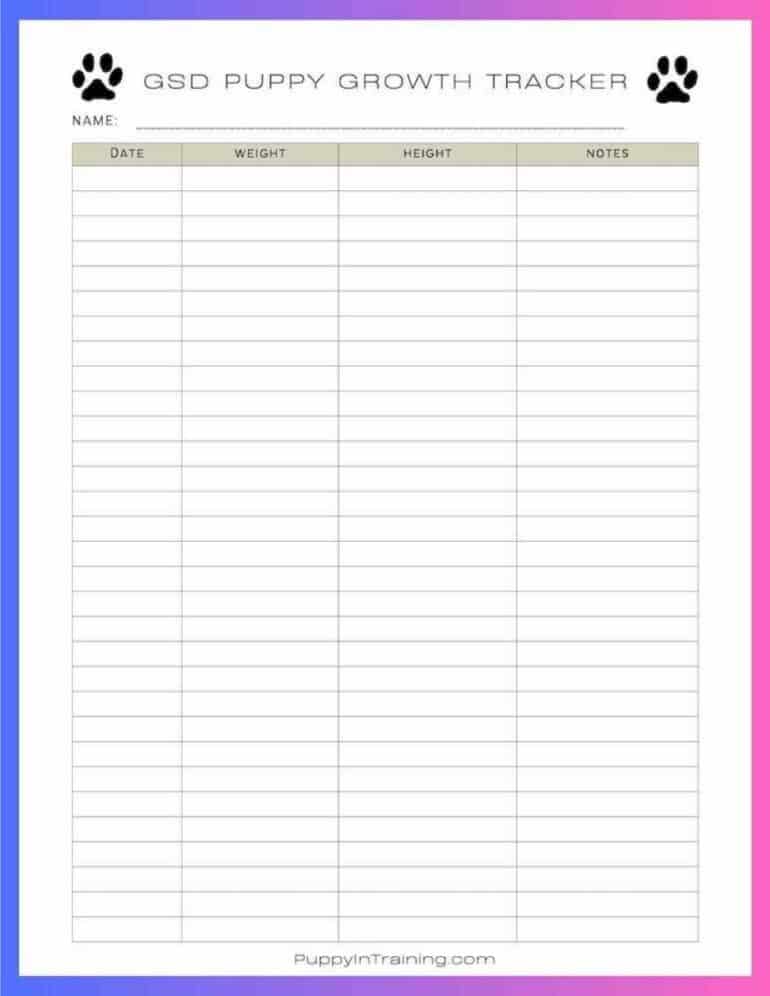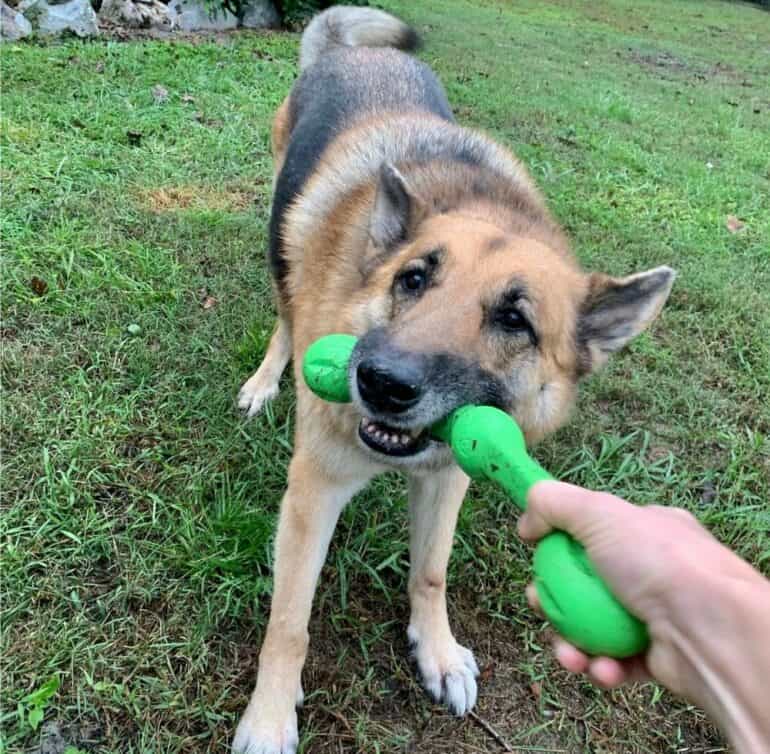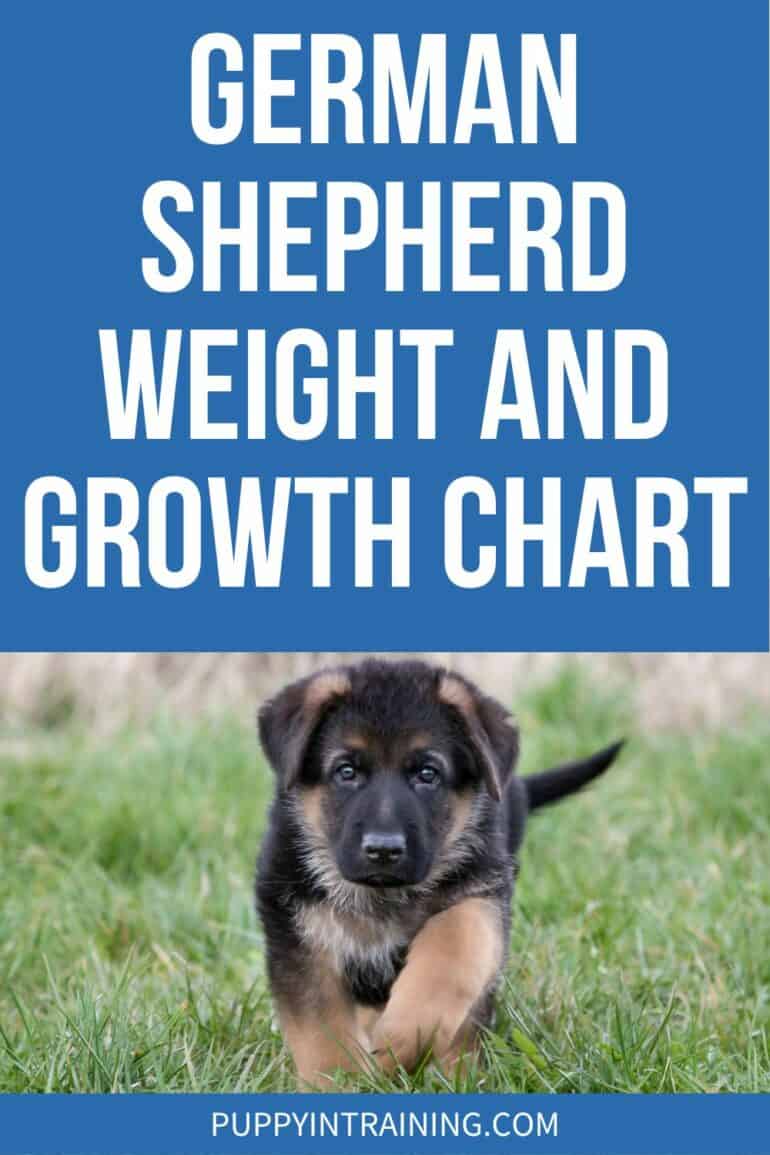German Shepherd Weight and Growth Chart
This post may contain affiliate links. We may earn money or products from the companies mentioned in this post.
If you recently brought a GSD puppy home, you’re probably wondering if they’re at the correct weight and height for their age!
After all, German Shepherd puppies grow quickly and before you know it, you’ll be shopping for larger dog collars and doggie beds.
Our German Shepherd Weight and Growth Chart gives you a general idea of what to expect for both female and male GSDs, and you’ll also learn all about the 5 German Shepherd puppy milestones.

Additionally, our free printable GSD Puppy Growth Tracker makes it easy to record your respective puppy’s weight and height.
Last but not least, we’ll also provide answers to the following questions:
- How do I weigh & measure my German Shepherd?
- At what age is a German Shepherd fully grown?
- How heavy is a fully-grown German Shepherd?
- What is overweight for a German Shepherd?
- Is a German Shepherd a good family dog?
- Are German Shepherds easy puppies?
- At what age does a German Shepherd start guarding?
- Should I speak German to my German Shepherd?
- How much exercise does a German Shepherd need?
If you’re just looking for information on GSDs because you’re contemplating bringing one home, you can use the following three links to find German Shepherd puppies from reputable breeders in the US as well as from GSD rescues:
- https://marketplace.akc.org/search-puppies (American Kennel Club)
- https://www.gsdca.org/breeders-classifieds/breeder-puppy-ads.html (German Shepherd Dog Club of America)
- https://www.agsra.org/affiliated-rescues (American German Shepherd Rescues)
For reputable German Shepherd breeders in Germany, check out the link below:
German Shepherd Stats
First things first, let’s start with some basic information about the German Shepherd Dog:
- Size: Medium-large
- Average Female GSD Height: 22”-24” / 56-61cm
- Average Female GSD Weight: 60-75 lb / 27-34 kg
- Average Male GSD Height: 24”-26” / 61-66 cm
- Average Male GSD Weight: 75-90 lb / 34-41 kg
- Colors: Tan with black saddle, sable, solid black, bi-color
- Lifespan: 9-13 years
- Litter Size: 4-9 puppies
- Coat Type: Short or long-haired, double coat
- Temperament: Intelligent, easy to train, loyal, playful, protective, alert, courageous
- Energy/Exercise Needs: High energy requiring lots of daily exercise
- Health Problems: Prone to hip dysplasia (especially show line GSDs)
German Shepherd Weight And Growth Charts
Please note that the GSD weight & growth charts below are average numbers of what to expect.
Generally speaking, your GSD puppy shouldn’t grow to be much larger than their parents.
That means your breeder should be able to give you a good general idea of your GSD puppy’s expected weight and growth.
Also, note that German Shepherds aren’t fully grown until they are about 2 years old, that’s why monitoring German Shepherd weight and growth throughout that time is important.
GSD puppies from different lines (show dog vs working dog) are also going to differ in weight and height.
Generally speaking, working GSDs tend to have a larger head and chest than show-line German Shepherds, but show lines are a bit bulkier than their working counterparts.
Additionally, show dog GSDs have shorter back legs and a more sloped back than working GSDs.
GSD breeder Christina Kaiser from Wendelin Farm in Canada breeds working line GSDs and shared the following average weight information for her working GSDs:
8 weeks 8 kg/17 lbs: Both female and male
Mature dog at 2 years of age:
- Female 60-75 lbs
- Male 75-90 lbs
She adds “we want a lean dog growing up, a dog that will grow slow and mature late.”
According to the American Kennel Club (AKC), the Official Standard of the GSD states that male GSDs measure 24-26” in height, and female GSDs measure 22-24” in height.
Again, please note that these are average values.
Average Expected Weight & Height For A Female GSD
| Age | Female GSD Weight Chart in lb | kg | Female GSD Growth Chart in in | cm |
|---|---|---|
| 4 weeks | 4-8 lb | 2-3.5 kg | 3-6” | 7.5-15 cm |
| 8 weeks | 10-17 lb | 4.5-8 kg | 6-9” | 15-23 cm |
| 12 weeks | 17-26 lb | 8-12 kg | 8-10” | 20-25.5 cm |
| 16 weeks | 31-35 lb | 14-16 kg | 10-12” | 25.5-30.5 cm |
| 5 months | 35-44 lb | 16-20 kg | 12-14” | 30.5-35.5 cm |
| 6 months | 44-49 lb | 20-22 kg | 15-17” | 38-43 cm |
| 7 months | 49-53 lb | 22-24 kg | 17-19” | 43-48 cm |
| 8 months | 53-57 lb | 24-26 kg | 18-20” | 46-51 cm |
| 9 months | 55-60 lb | 25-27 kg | 19-21” | 48-53 cm |
| 10 months | 57-62 lb | 26-28 kg | 19-21” | 48-53 cm |
| 11 months | 60-64 lb | 27-29 kg | 20-22” | 51-56 cm |
| 12 months | 60-64 lb | 27-29 kg | 20-22” | 51-56 cm |
| 18 months | 60-66 lb | 27-30 kg | 21-22” | 53-56 cm |
| 2 years | 60-75 lb | 27-34 kg | 22-24” | 56-61 cm |
Bonus: Your own printable German Shepherd puppy growth tracker! Grab yours here.

Average Expected Weight & Height For A Male GSD
| Age | Male GSD Weight Chart in lb | kg | Male GSD Growth Chart in in | cm |
| 4 weeks | 5-9 lb | 2-4 kg | 4-6” | 10-15 cm |
| 8 weeks | 10-17 lb | 4.5-8 kg | 7-9” | 18-23 cm |
| 12 weeks | 20-30 lb | 9-13 kg | 9-11” | 23-28 cm |
| 16 weeks | 30-40 lb | 13-18 kg | 11-14” | 28-35.5 cm |
| 5 months | 40-49 lb | 18-22 kg | 14-16” | 35.5-40.5 cm |
| 6 months | 50-55 lb | 22.5-25 kg | 16-18” | 40.5-46 cm |
| 7 months | 55-62 lb | 25-28 kg | 19-20” | 48-51 cm |
| 8 months | 62-68 lb | 28-31 kg | 20-22” | 51-56 cm |
| 9 months | 65-70 lb | 29.5-32 kg | 21-23” | 53-58.5 cm |
| 10 months | 66-75 lb | 30-34 kg | 22-24” | 56-61 cm |
| 11 months | 66-75 lb | 30-34 kg | 22-24” | 56-61 cm |
| 12 months | 70-75 lb | 32-34 kg | 22-24” | 56-61 cm |
| 18 months | 70-80 lb | 32-36 kg | 23-25” | 58.5-63.5 cm |
| 2 years | 75-90 lb | 34-41 kg | 24-26” | 61-66 cm |
How Do I Weigh & Measure My German Shepherd?
In order to measure your GSD’s height, have them stand and grab a (soft) measuring tape.
Next, measure from their paws to the top of their shoulder blades.
To get your puppy’s weight, you can use 3 different approaches:
- Take your pup to your vet’s office outside of their scheduled medical checkups to get their weight. You can safely do this once they’ve had all of their initial puppy shots. These quick pop-ins will be great for their ongoing socialization!
- Invest in a digital pet scale for puppies (max capacity 220 lbs) or in a heavy-duty pet scale for larger dogs (max capacity 440 lbs).
- Stand on your own bathroom scale and write down your weight. Step off and grab your puppy. Next, step back on with your GSD puppy and take that weight. Subtract your weight from the combined weight, and you’ll have your puppy’s weight.
5 German Shepherd Puppy Milestones
There are 5 milestones in your German Shepherd puppy’s development:
- The Neonatal Period
- The Socialization Period
- The Juvenile Period
- The Sexual Maturity Period
- The Transition-Into-Adulthood Period
The Neonatal Period (0-3 weeks)
This period encompasses the time from birth until 3 weeks of age.
The puppies are born blind and deaf and are completely dependent on their mother for the first 2 weeks of their life.
At about the 2-3 week mark, the puppies’ ears and eyes are fully open, they’re starting to stand and are taking their first puppy steps.
This is also when their first baby teeth are coming in.
The Socialization Period (3-12 weeks)
During this time span, the puppies are learning social skills.
Those are really important as a well-socialized puppy will turn into a confident adult who’s not scared of new environments!
They’ll first start learning from their mother and siblings, followed by the breeder who begins to expose them to their human family, lots of sounds, and gadgets.
If the puppies go to their new homes at 8 weeks of age, it’s important that their new owners continue the puppy’s socialization to the world with all of its sounds, sights, and smells.
One benefit of having the puppy stay with the breeder until they’re 12 or even 16 weeks old is that an experienced breeder will start their house training as well as leash training during that time.
The Juvenile Period (4-6 months)
This is another formative time for German Shepherd puppies as they continue to explore the world.
They’ll be settling into their new home while continuing their socialization to the world.
They’ll also go through their teething phase as their adult teeth come in, and finish their house training.
The Sexual Maturity Period (6-18 months)
During this time, your GSD puppy will get all of their adult teeth and their ears will transition from floppy to erect.
Female GSD puppies will also go through their first heat cycle and male GSD puppies will reach sexual maturity.
Good to know: Female GSDs stay in heat for 3-4 weeks.
This happens once to twice per year, so unless you’re intending to and have the right to breed your pup (check your puppy contract!), you’ll want to spay or neuter your GSD puppy during this time.
The Transition-Into-Adulthood Period (18 months – 2.5 years)
During this period, your German Shepherd will continue to grow.
A good indicator that your GSD puppy has more growing to do is when their paws still seem too large compared to the rest of the body.
The picture below shows my former dog walking client Stanley, a male long-haired GSD when he was about 1 ½ years old.
Back then, he still hadn’t grown into his paws!

Former male GSD client Stanley, still not fully grown at 1.5 years young
At What Age Is a German Shepherd Fully Grown?
Many German Shepherds will reach their final height pretty quickly,
but will continue to bulk out until they’re 1 ½ – 2 years old.
Most are fully grown at about 2 years of age, but some may continue to bulk out until they’re 2.5 years old (30 months).
How Heavy is a Fully Grown German Shepherd?
Of course, this depends on the individual dog, but generally speaking, fully grown female German Shepherds weigh between 60-75 lbs.
Fully grown male German Shepherds weigh between 75-90 lb on average.
Remember that GSDs from show lines are typically larger and bulkier than working GSDs.
What is Overweight for a German Shepherd?
Lack of regular breed-specific exercise can cause your German Shepherd to become overweight.
Obesity can contribute to joint issues and a host of other health problems including diabetes and kidney disease, so it’s in your best interest to keep your GSD lean and fit!
Generally speaking and just like other dog breeds, German Shepherds are considered overweight if they no longer have an abdominal tuck.
With that in mind, you should be able to clearly see a waistline in your German Shepherd when you look at it from above.
Another good hack is when you can easily feel your GSD’s ribs and they don’t have a sagging belly, they’re not overweight.
When there are layers of fat covering their ribs and they have a sagging belly, your pup is overweight.
For most female GSDs, weighing in over 75 lb is likely overweight.
For most male GSDs, the weight cutoff is 90 lb, but it’ll depend on your respective pup.
The runt of the litter is always going to be much smaller than the biggest sibling pup!
German Shepherd breeder Christina Kaiser from Wendelin Farm in Canada raises working-line GSDs and wants to feel the ribs in an athletic dog that is in working condition.
According to her:
A dog is too fat when you won’t feel [their] ribs. A German Shepherd could be 100 lbs and not be fat, and another German Shepherd could be 75 lbs and fat.
Here’s a YouTube video of one of her working GSDs:
Is a German Shepherd a Good Family Dog?
With proper socialization and training, GSDs make great family dogs who bond well with children, especially females.
Beyond that, they are loyal and protective of their families, including kids.
Originally bred as a herding dog, keep in mind that German Shepherds are high-energy working dogs, so they need a proper outlet for all of that energy.
Especially working line German Shepherds!
If their exercise needs aren’t met, they can quickly develop problem behaviors as they find ways to entertain themselves.
For example, destroying your furniture, barking obsessively at everything they see out of the window, chewing through their crate in attempts to escape, nipping at people’s heels, etc.
All that said, you’ll need to lead an active lifestyle that caters to your German Shepherd’s energy. Activities you can do together are:
- Jogging
- Biking
- Rollerblading
- Canicross
- Skijoring
- Swimming
- Retrieving
- Schutzhund
- Hiking
- Agility
- Dock diving
- Backpacking
Are German Shepherds Easy Puppies?
Raising any puppy requires a lot of time, energy, consistency, and dedication on the handler’s part. However, there are certain breeds that are easier to train than others.
Thankfully, German Shepherds fit into that category because they are very intelligent and quick learners.
This includes house training, crate training, basic obedience commands as well as learning tricks.
We recommend attending a puppy kindergarten class as part of your German Shepherd puppy socialization strategy.
Once your pup’s successfully graduated from it, you can enroll them in basic obedience classes.
At What Age Does a German Shepherd Start Guarding?
Once your pup knows their basic obedience commands, you can enroll them in Schutzhund training aka IPO.
Schutzhund is the German term for “Protection Dog”, and IPO is short for “Internationale Prüfungsordnung”, which translates to “International Testing Standards”.
Schutzhund training teaches your pup to do protection work paired with tracking, guarding, and 100% off-leash, voice control obedience (no hand signals).
Partnership and teamwork between yourself and your dog are the basis for this type of training.
After all, it’s where they learn to completely focus on their handler and ignore all distractions including other people, dogs as well and loud noises such as gunshots.
Note that the Schutzhund environment is not a place for dogs with aggression issues, neither towards other dogs nor people!
While you can Schutzhund train with your pup for fun and to strengthen the bond between you, there’s also the option to compete in this dog sport.
You can enroll your GSD pup for IPO 1 once they’re 18 months old.
If they pass that initial level which includes a temperament test, they can move on to IPO 2 (minimum age 19 months) and IPO 3 (minimum age 20 months).
That said, protection dog trainers recommend starting training classes that include bite work and high jumps once your German Shepherd puppy is 12 months old.
Younger GSDs shouldn’t do this type of strenuous exercise to avoid damaging their growing joints and growth plates.
If you’re interested in learning more about the Schutzhund sport, check out the United Schutzhund Club of America here.
Should I Speak German to My German Shepherd?
It’s actually common to use German obedience commands in Schutzhund training, yes.
Dutch and Czech are two other languages which commands are frequently taught.
Stanley, my former long-haired GSD dog-walking client, started going to Schutzhund training when he was a little over 12 months old.
His owners practiced commands in German with him on a daily basis, and I remember getting a printout of his German commands as they asked me to use them on our walks as well.
However, unless you’re serious about turning your dog into a protection dog, you don’t have to speak German to your German Shepherd.
How Much Exercise Does a German Shepherd Need?
Lots, ha!
German Shepherds need a minimum of 2 hours of physical exercise per day, but generally speaking, the more exercise you can provide your GSD with, the more they will thrive.
Remember, German Shepherds are high-energy, athletic dogs bred to be active all day long, especially if they come from a working line!
Physical Exercise Ideas for German Shepherds
As far as physical exercise, this can be a mix of walks, runs, bike rides, fetch and playtime.
…and no, backyard time alone doesn’t cut it, although a big, fenced-in yard is great for frisbee and ball time as well as tug!

This is Nala, one of my former pet-sitting clients. She was crazy about frisbees and balls.

Playing tug with a friend’s senior GSD, Hannibal.
The West Paw Echo Zwig dog toys are great for playing tug with German Shepherds because it’s easy to hold them during playtime.
One of my favorite ways of increasing the energy and calories a dog burns on a regular walk or hike is by using a doggie backpack.
That’s a good exercise hack if you’re not big on running or biking yourself.
I’ve tested several ones over the years and found that Ruffwear and One Tigris make the most durable dog backpacks.
Although they’re not waterproof per se, they can take a downpour or dip in the lake or ocean no problem. All I’ve ever done is wipe them down and let them air dry, and voilà.
Mental Stimulation for German Shepherds
Besides providing a good physical workout, dog backpacks also burn mental energy. That’s because they make the dog focus on the job of carrying something.
Other ideas for mental stimulation for German Shepherds are games like hide & seek, nose work, treat dispensing dog toys, trick training as well and practicing obedience commands in general.
If your German Shepherd doesn’t get enough physical and mental exercise, they can get bored in a heartbeat.
As you probably know, bored dogs can quickly become destructive as they figure out ways of entertaining themselves.
For example, chewing up your furniture and shoes, scratching doors, raiding your kitchen trash can, or digging up your flower beds.
So do yourself a favor and make sure your GSD gets plenty of exercise on a daily basis.
Remember, a tired dog is a good dog, and that applies to German Shepherds as much as it does to any other dog breed!

Former GSD client Remi pooped after a long walk.
Bottom Line
So, how big does a German Shepherd get?
Well, German Shepherds are medium to large size dogs, so they can weigh anywhere between 60-100 lbs.
That said, the average expected weight for a male GSD is between 75-90 lbs, and the average expected weight for a female GSD is between 60-75 lbs.
Both reach sexual maturity somewhere between 6-18 months and are considered fully grown at about the 2-year mark.
However, some (mostly male) German Shepherds will continue to bulk out until they’re 2.5 years old.
Remember that your puppy’s lineage plays an important role in their expected size, including the weight and height of your GSD puppy’s parents and the line they come from.
Keeping that in mind, your GSD breeder should be able to give you a good general idea of how big your German Shepherd puppy will grow to be!
Save To Pinterest

Top Picks For Our Puppies
- BEST DOG CHEW
We Like: Beef Collagen Sticks - All of our pups love to bite, nip, and chew. We love using Collagen Sticks to help divert these unwanted behaviors. - BEST PUPPY TOY
We Like: Calmeroos Puppy Toy w/ Heartbeat and Heat Packs - Perfect for new puppies. Helps ease anxiety in their new home. - BEST DOG TREATS
We Like: Crazy Dog Train-Me Treats - We use these as our high-value treats for our guide dog puppies. - BEST FRESH DOG FOOD
We Like: The Farmer's Dog - A couple months ago we started feeding Raven fresh dog food and she loves it! Get 50% off your first order of The Farmer's Dog.
Check out more of our favorites on our New Puppy Checklist.